Events and excursions, Summer 2022
Thoroton and FONA’s birthday celebrations
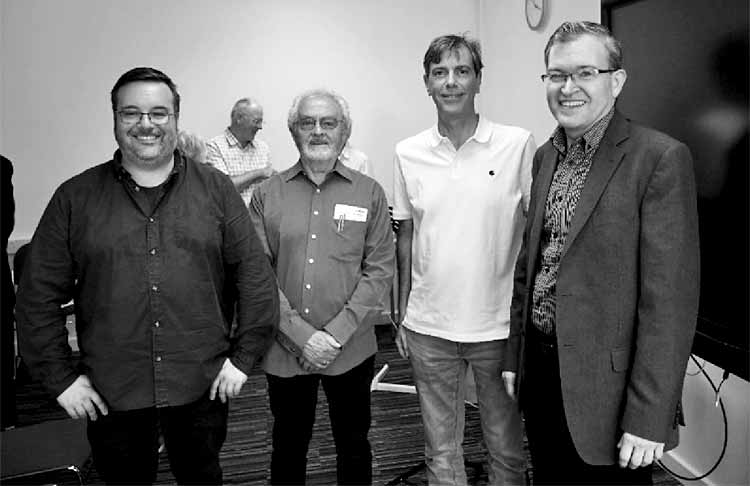
Chris King, Graham Crisp, Andrea Moneta the three speakers on the Thoroton Day with Richard Gaunt who chaired the Thoroton day on Wednesday 13th July.
The very successful FONA and Thoroton Society birthday celebrations opened on Saturday 9th July with a series of lectures introduced by John Hess.
There were a series of short talks to mark the 1th Anniversary of the Friends of Nottinghamshire Archives and the 125th Anniversary of the Thoroton Society. Judith Mills (Chair of FONA) and Richard Gaunt, both gave a short resume of their history before Ruth Imeson, the History Services Manager at Nottinghamshire Archives gave us a presentation on the ‘History of Nottinghamshire in 20 archives’. Paul Bradshaw finished the first day of celebrations with his talk on ‘Documents to Documentaries’, Viral History, using archival sources to inform factual video content. He showed how he had developed the programme on Richard Thomas Parker, the last man to be hanged in Nottingham. What a tremendous start to four days of celebration.
On Tuesday 12th there were three short talks about documents purchased by FONA. Titles the 3W’s, Woodborough , Winkburn and a Wedding, exploring how one document can inspire and add to existing knowledge to create further research. Mike Chapman of Woodborough Heritage Group, Sheila Leeds of FONA, and Peter Duke of Nottinghamshire Family History Society, inspired the audience with their research and the existing knowledge’
Three excellent presentations to celebrate the 125th birthday of the Thoroton Society took place on Wednesday 13th July the three Thoroton Society speakers in the photograph at the beginning of this report gave us an inspiring afternoon of Archaeology and History. Chris King (University of Nottingham) started with the findings of a new University-led project on the exploration of the archaeology and history of the caves associated with the Broadmarsh site. He developed what we know about the caves use in the past. This was followed by Andrea Moneta (Nottingham Trent University) talking about a research project to recreate digitally the Market Wall in the Old Market Square. He showed how the hidden heritage could be revealed and suggested how it could be used to reveal unknown roots of the city in the future. Finally Graham Crisp of the Thoroton Society spoke on the transcription of the Stapleford Constable Accounts (1650-1585). He described how he came to transcribe the document, the process he used and the interest that the publication would offer to readers and researchers.
On Thursday 1th July there was a final day of celebrating the birthdays when there was a morning on looking at three themes that had emerged from the previously uncatalogued collection of documents relating to the Savile family. Sheila Leeds, Ruth Strong and Karen Witard gave us a full morning on The Savile Estates- Land and People (1740-1840), the Savile Estate’s Village and People (1891-1901) and Augustus William Lumley Savile,
A Forgotten Artist and his Circle. So ended the birthday celebrations of FONA and the Thoroton Society.
Four days of celebration through this excellent programme of talks and an exhibition of documents. Thank you to Judith Mills, and Richard Gaunt for the organisation and to Ruth Imeson for making us so welcomed and the use of the Nottinghamshire Archives
Paul Baker
A splendid afternoon at Car Colston, Saturday 30th July
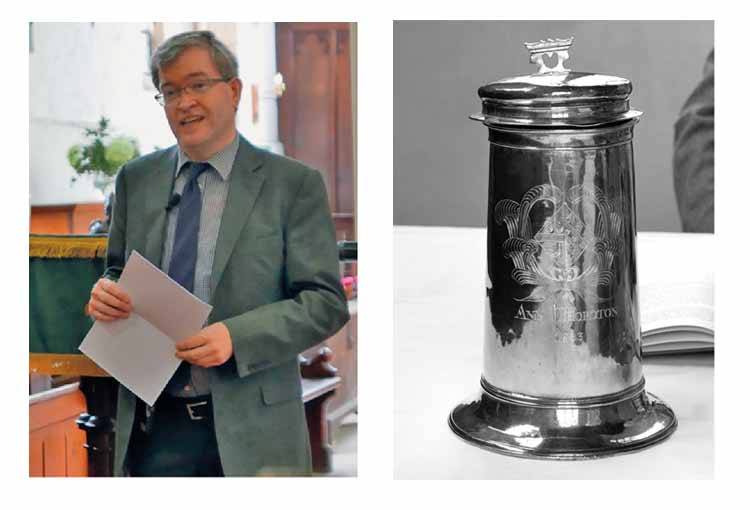
Richard Gaunt addressing Thoroton Society members at Car Colston (left) and Thoroton silver at Car Colston (right).
We received a very welcome invitation from St Mary’s Church Parochial Church Council last year - to visit the church and hold an event to celebrate our 125th anniversary. This, as you will be aware, is a very appropriate village to hold such a celebration, being where Robert Thoroton, the Society’s inspiration and namesake lived, and died. The Standing Committee was delighted to accept the invitation and planning began.
David Hoskins and I met up with Churchwarden Gill to discuss the possibilities - and a suitable date. Saturday, 30th July 2022 was decided upon and a programme began to be devised. Obviously, there would be a focus on Dr Thoroton and we turned to Dr RT expert, Adrian Henstock but, alas, Adrian was booked on a holiday and wouldn’t be able to present the keynote talk.
He wasn’t, however, going to get away with it so lightly. His offer to put together a Dr Thoroton timeline to guide the speaker was gratefully accepted: our Chair, Richard Gaunt, was the one to be handed the baton. Also to be included in the programme was the long- postponed performance by the City of Lincoln Waites, the previous concert having been cancelled due to the pandemic lockdown. And, of course, there was to be a society tea - a long-held tradition.
Well, the day arrived with a goodly number of members and local people in attendance. We were warmly welcomed by the Revd Ruth Colby, Vicar of Car Colston (and of another four churches).
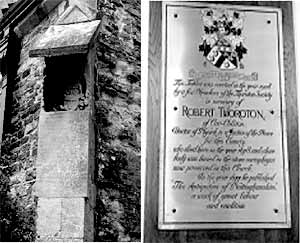
The Thoroton Buttress and the plaque to Robert Thoroton.
Richard Gaunt, in this auspicious 125th anniversary year of the Society, reminded those present of the links between Dr Thoroton and our society. He drew our attention to the fact that a number of Thoroton Society members had visited Car Colston back in 1908 when a commemorative plaque was presented to the church to mark the relationship between the society, Dr Thoroton and, most fittingly, St Mary’s itself. The plaque hangs there still on the south wall - and, as Richard said, it is notable that it records that it was the gift of “a few members” - why it was necessary to make that comment is a matter of conjecture.
We were then addressed by Henry Blagg of the long-standing local family, also with close associations with the Society - Thomas Blagg was a founder member of the Society. Henry’s late father had written a history of the parish 54 years ago and had noted the changes made during his lifetime - motor power, television and the BBC, the start of mechanised farming. Henry then spoke of the greater changes during the subsequent 54 years since his father’s time - Car Colston had then been a very agrarian village with considerable numbers of farmers, now there were only three farms of significance, with no new farmers since 1968. There was now the internet, mobile phones, multiple car ownership. But there was also more woodland with buzzards, blackcaps etc. However significant changes that were likely to impact on Car Colston were the semi-suburban growth of Bingham and Newton, the easier access to London and the dualled A46 - gone the Fosse Way as we knew it. However, the church was still central to the village, also providing a place for concerts and recitals: the Royal Oak was thriving, as was the Cricket Club. And, despite agrarian change, the village is still recognisable as the place it was in the 1950s. There are several hatchments and other memorials to the Blagg family in St Mary’s - interestingly they too had surgeons in the family.
Richard then gave a very interesting and detailed illustrated account of Dr Robert Thoroton including details of his ancestry, of his education including his time at Christ’s College, Cambridge from which he graduated with a BA and subsequently an MA, his marriage to Anne Boun and their three daughters of which Mary, aged 3, accidentally drowned.
The development of his medical career and his growing interest in local and family history was well covered in the talk, as was the recognition of his genealogical talent by William Dugdale, author of a history of Warwickshire, which led to Thoroton’s compiling of the Antiquities of Nottinghamshire. Of the memorials to Dr Thoroton in the church we heard how his elaborate coffin and its lid was found and eventually raised in 1863 and brought into the church, how Thomas Blagg had found the grave marker, probably a reused altar table, with Thoroton’s name on it, and the location of the family memorial plaque on an angled buttress of the church.
The talk was followed by a short break to allow members to take a walk around the church admiring the carvings and also the Thoroton silver which the Churchwardens had displayed on the altar especially for this day. Many also ventured outside to admire the architecture of this wonderful church and its attractive churchyard.
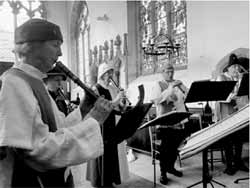
Lincoln Waites at Car Colston church.
Then for another highlight of the day - a superb recital by the City of Lincoln Waites. Despite having to wait a couple of years for the Waites, as it happened St Mary’s was an ideal venue for their recital, with just the right atmosphere. We were all mesmerised by the range of music, instruments and costumes which the six members of the group presented to us. They played a programme of 15th to 16th century music on a vast array of crumhorns, tabors, pipes, sackbutts - along with a symphony and a cornamuse! It was a wonderful display of virtuosity, ending with “sumer is a-coming in” sung by Ann and accompanied by the others on their various instruments.
Then there was the “tea” served by our hosts which was greatly appreciated by Society members who, on the whole, are tea aficionados! We are delighted to have forged this new relationship with St Mary’s and her people. We are so grateful for the preparations they made for us and the welcome we received. And we wish them well in their ambition to restore the bells and to give the Thoroton tomb a greater focus. We look forward to future events in what feels like our Society’s home church.
Barbara Cast
The Nottinghamshire Church Notes of Sir Stephen Glynne
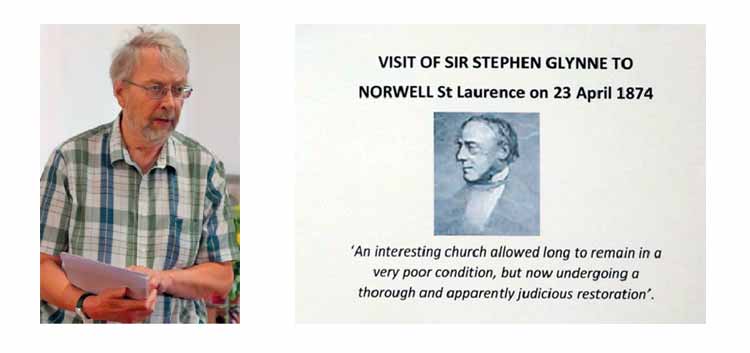 John Beckett speaking at Norwell church (left) and plaque at Norwell church commemorating the visit of Sir Stephen Glynne (right).
John Beckett speaking at Norwell church (left) and plaque at Norwell church commemorating the visit of Sir Stephen Glynne (right).The Thoroton Society visited Norwell, in bright summer sunshine, to launch The Nottinghamshire Church Notes of Sir Stephen Glynne, which was published in the Society’s Record Series in 2020. Covid had intervened to prevent an official launch event for some time, but, as it turned out, the timing of the event could hardly have been better. The book was launched at St Laurence’s church in Norwell on St Laurence’s day (10th August). The venue was chosen because it was the last of the Nottinghamshire churches visited by Glynne, a noted antiquarian, before his death in 1874. Best known today as the brotherin-law of the Liberal politician William Ewart Gladstone, Glynne, of Hawarden Castle, North Wales, made regular summer pilgrimages to churches across the country. The Nottinghamshire volume was transcribed almost completely by the late Laurence Butler. Following his death in 2015, the transcript was located by Paul Stamper, passed to John Beckett for completion, and now been published in an attractive and competitively priced edition. John explained the importance of the church notes, which have been widely used in the Nottinghamshire Church project, run by John and Chris Brooke since 1999. He also read a message of thanks and appreciation from Laurence Butler’s daughter, who was unable to attend in person. Elizabeth and Michael Jones, our hosts at Norwell, and founts of knowledge on all things relating to the church and village, gave us incisive short presentations on the church and its place in the community. Elizabeth had signposted visitors to artefacts within the church which Glynne noted at the time of his visit and explained his lukewarm appreciation of the church by reference to the fact that it was undergoing a major restoration at the time. Following a very welcome lunch served on dinner plates which the Jones family had bought in an auction of Gladstone family possessions at Hawarden (from where Michael’s family originate) we were taken on a tour of Norwell, finding as much shade as possible in the heat of an August afternoon. Michael gave fascinating insights into the architecture and social history of Norwell, noting its rule of three - it has three surviving vicarages, and three surviving schools. There were many apt connections between Hawarden, Glynne and Norwell, as well as the fortuitous scheduling of the day on the saint’s day of the church, that everyone agreed that a return visit is called for soon. The Society is indebted to all those who planned, attended and participated in the event, for a highly successful and memorable launch. Copies of the book are available via the website or by contacting Rob James.
Richard A. Gaunt